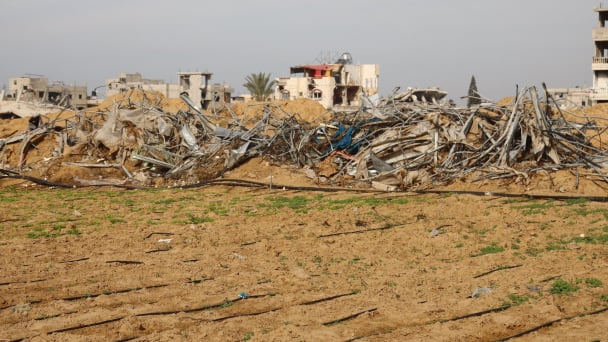May 30, 2025 | 12:30 GMT +7
May 30, 2025 | 12:30 GMT +7
Hotline: 0913.378.918
May 30, 2025 | 12:30 GMT +7
Hotline: 0913.378.918
Wheat farmers across the country are facing lower yields as 98% of the country’s wheat crop is in areas experiencing drought.
In the Northern Plains, the Department of Agriculture said Monday that farmers were projected to harvest their smallest crop of spring wheat—crops planted in the spring and harvested in the autumn—in 33 years. This week, the North Dakota Wheat Commission noted in its weekly update that some farmers saw rain and lowered temperatures following last week’s searing heat, but conditions are still worrisome.
The region is hardly alone; the USDA also said this week that 68% of the Pacific Northwest’s spring wheat was in “poor or very poor” conditions. At this time last, only 6% of the region’s wheat crop was in this state. All told, the USDA found that 98% of the U.S. wheat crop is growing in areas hit by drought.
“Producers in the driest areas continue to make choices on abandoning or haying their wheat crop depending on yield potential,” the North Dakota Wheat Commission notes. “Temperatures for this week will turn hot again, causing concerns for wheat that is in the grain filling stages.”
June is when the wheat planted in the spring flowers, and is “a critical period” for the crop, said Ariel Ortiz-Bobea, an associate professor of applied economics at Cornell. “It’s getting hit very hard right now, the conditions being reported are pretty bad.”
Ortiz-Bobea explained that a dry month when wheat is in this crucial stage can really damage the overall yield of the crop, regardless of what the weather looks like afterward. “Each little kernel is like a womb—you need them to be viable,” he said. “During the period of time where the harvested part of the plant is irreversibly set, if you have a stress, like heat or drought, the instinct of the plant is to cut losses and focus on fewer things. Many flowers abort, and the plant says, ‘well, I’m just going to save these guys,’ so the yield goes down, even if conditions afterward are ideal.”
Wheat in the U.S., Ortiz-Bobea said, is also mostly rainfed. Farmers don’t irrigate wheat fields, which lowers productions costs and doesn’t tap into scarce water resources.
“A lot of irrigation in the West is for very high-value crops—almonds, fruit trees, vegetables—they require a lot of water, but you can sell for a very high price,” he said. But this lack of irrigation infrastructure can be devastating for farmers when drought coupled with record-setting heat hits at such a crucial growing time. The Pacific Northwest saw ground temperatures rise to 145 degrees Fahrenheit (63 degrees Celsius) during the heat wave worsened by climate change earlier this month, with the worst readings in the parts of Washington and Oregon where wheat is grown.
“When you get a heatwave like this, when the crop is vulnerable, there’s not much farmers can do,” Ortiz-Bobea said.
The entire state of Oregon and Idaho are in drought as is much of Washington, including the eastern part of the state where wheat largely grows. Farmers are scrambling to handle the one-two punch of drought and a searing heatwave.
“The general mood among farmers in my area is as dire as I’ve ever seen it,” farmer Cordell Kress, who farms wheat and canola in Idaho, told Reuters. “Something about a drought like this just wears on you. You see your blood, sweat, and tears just slowly wither away and die.”
The damage to the Northwest wheat crop isn’t just a concern to farmers, but anyone who likes cakes, pastries, biscuits, ramen noodles, and a lot of other delicate, tasty stuff. The varieties of wheat hit hard by the drought and the heat in those states are what are known as soft white, and it’s the only place in the U.S. that grows this kind of wheat. Soft white wheat is good for pastries and the like because of its low protein content, which makes it less stretchy than traditional flour. But wheat kernels in the Pacific Northwest are shriveling due to the heat and the drought, upping their protein content—and meaning that a lot of the crop that will be harvested won’t be suitable for the soft wheat market.
While Ortiz-Bobea said that bulk wheat purchasers are “scrambling” trying to figure out markets with less wheat supply, for anyone worrying about flour flying off the shelves, you can rest easy. “For the consumer, at the end of the day, they might not even notice it,” he said.
This summer’s wheat woes are a look into how crop yields may start to sputter more regularly, even as agriculture makes technological advancements. Ortiz-Bobea coauthored a study published in Nature Climate Change earlier this year that found that climate change has already made global farming productivity 21% lower than it could have been—the equivalent of making no improvements in productivity for seven years.
“This is going to become more frequent,” he said. “Climate change is already slowing down productivity at a global scale. It’s already happening but we don’t see it because this is a bad year compared to the previous one. We’re comparing today versus yesterday because we’re not thinking about what could have been.”
(Gizmodo.com)

(VAN) Vikas Rambal has quietly built a $5 billion business empire in manufacturing, property and solar, and catapulted onto the Rich List.

(VAN) Available cropland now at less than five percent, according to latest geospatial assessment from FAO and UNOSAT.

(VAN) Alt Carbon has raised $12 million in a seed round as it plans to scale its carbon dioxide removal work in the South Asian nation.

(VAN) Attempts to bring down the price of the Japanese staple have had little effect amid a cost-of-living crisis.

(VAN) Fourth most important food crop in peril as Latin America and Caribbean suffer from slow-onset climate disaster.

(VAN) Shifting market dynamics and the noise around new legislation has propelled Trouw Nutrition’s research around early life nutrition in poultry. Today, it continues to be a key area of research.

(VAN) India is concerned about its food security and the livelihoods of its farmers if more US food imports are allowed.